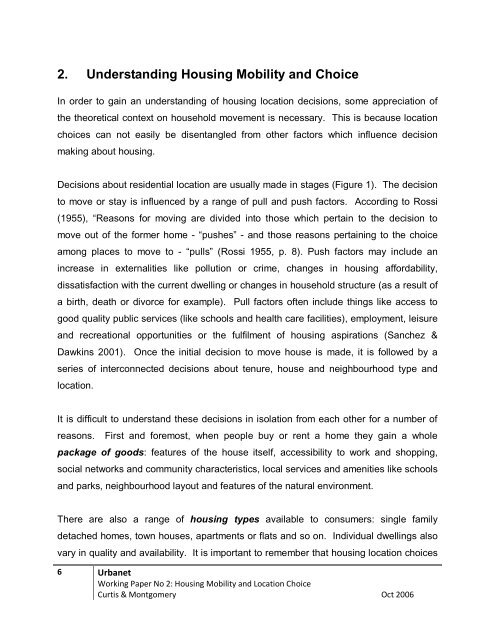Housing Mobility and Location Choice - Urbanet - Curtin University
Housing Mobility and Location Choice - Urbanet - Curtin University
Housing Mobility and Location Choice - Urbanet - Curtin University
Create successful ePaper yourself
Turn your PDF publications into a flip-book with our unique Google optimized e-Paper software.
2. Underst<strong>and</strong>ing <strong>Housing</strong> <strong>Mobility</strong> <strong>and</strong> <strong>Choice</strong><br />
In order to gain an underst<strong>and</strong>ing of housing location decisions, some appreciation of<br />
the theoretical context on household movement is necessary. This is because location<br />
choices can not easily be disentangled from other factors which influence decision<br />
making about housing.<br />
Decisions about residential location are usually made in stages (Figure 1). The decision<br />
to move or stay is influenced by a range of pull <strong>and</strong> push factors. According to Rossi<br />
(1955), “Reasons for moving are divided into those which pertain to the decision to<br />
move out of the former home - “pushes” - <strong>and</strong> those reasons pertaining to the choice<br />
among places to move to - “pulls” (Rossi 1955, p. 8). Push factors may include an<br />
increase in externalities like pollution or crime, changes in housing affordability,<br />
dissatisfaction with the current dwelling or changes in household structure (as a result of<br />
a birth, death or divorce for example). Pull factors often include things like access to<br />
good quality public services (like schools <strong>and</strong> health care facilities), employment, leisure<br />
<strong>and</strong> recreational opportunities or the fulfilment of housing aspirations (Sanchez &<br />
Dawkins 2001). Once the initial decision to move house is made, it is followed by a<br />
series of interconnected decisions about tenure, house <strong>and</strong> neighbourhood type <strong>and</strong><br />
location.<br />
It is difficult to underst<strong>and</strong> these decisions in isolation from each other for a number of<br />
reasons. First <strong>and</strong> foremost, when people buy or rent a home they gain a whole<br />
package of goods: features of the house itself, accessibility to work <strong>and</strong> shopping,<br />
social networks <strong>and</strong> community characteristics, local services <strong>and</strong> amenities like schools<br />
<strong>and</strong> parks, neighbourhood layout <strong>and</strong> features of the natural environment.<br />
There are also a range of housing types available to consumers: single family<br />
detached homes, town houses, apartments or flats <strong>and</strong> so on. Individual dwellings also<br />
vary in quality <strong>and</strong> availability. It is important to remember that housing location choices<br />
6 <strong>Urbanet</strong><br />
Working Paper No 2: <strong>Housing</strong> <strong>Mobility</strong> <strong>and</strong> <strong>Location</strong> <strong>Choice</strong><br />
Curtis & Montgomery Oct 2006


